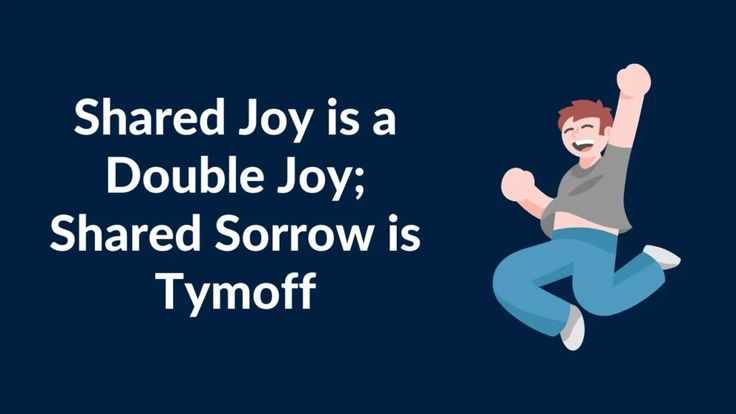The phrase “shared joy is a double joy; shared sorrow is tymoff” speaks to the idea that emotions, whether positive or negative, grow and evolve when they are shared with others. This concept is deeply rooted in human psychology and sociology. When we share happiness, it seems to multiply, creating a more profound sense of connection and fulfillment. On the other hand, sharing sorrow doesn’t necessarily increase it but helps dilute the pain, making it easier to carry.
What Does “shared joy is a double joy; shared sorrow is tymoff?
In simple words, shared joy is a double joy; shared sorrow is tymoff becomes even greater when we celebrate it with someone else, while sadness becomes easier to bear when we express it with a trusted friend or group. Shared emotions create a bond between people, whether they are celebrating a moment of success or grieving a loss. This idea encourages us to be open about our emotions, knowing that connection with others is a powerful tool for both personal happiness and emotional healing.
Key Elements of the Phrase:
- Joy increases when shared: The feeling of happiness grows when expressed with others.
- Sorrow eases when shared: Sharing grief lightens the emotional load.
This expression highlights the importance of relationships and emotional expression, especially in a world where isolation can lead to a buildup of stress or loneliness.
The Science Behind Shared Emotions: How Sharing Amplifies Joy and Eases Sorrow
The power of shared emotions is backed by science. When we shared joy is a double joy; shared sorrow is tymoff or sorrow with others, our brains react in specific ways that enhance or ease our feelings. For example, when we share a happy experience, the brain releases dopamine, often referred to as the “feel-good” hormone, which intensifies our positive emotions. This is why celebrating milestones or good news with others tends to make us feel even better. Oxytocin, known as the bonding hormone, is also released when we share emotions, helping strengthen connections between people.
On the flip side, when we share sorrow, our brains respond by helping to alleviate the emotional burden. Sharing sorrow with others often leads to feelings of validation, empathy, and comfort. This emotional support can activate the prefrontal cortex, the part of the brain responsible for regulating emotions. Studies show that talking about grief or sadness with trusted individuals reduces the intensity of negative feelings, which helps ease emotional pain. In this way, sharing both shared joy is a double joy; shared sorrow is tymoff is crucial for our emotional well-being, helping us process complex emotions in a healthier and more balanced way.
Shared Joy Is a Double Joy: Why Happiness Grows When It’s Shared
When we share shared joy is a double joy; shared sorrow is tymoff moments, our happiness doesn’t just remain the same—it multiplies. Think about a time when you received good news. Did your joy feel more complete when you shared it with friends or family? The emotional impact of joy intensifies when others acknowledge and celebrate it with us. This effect is often seen in community celebrations, team victories, or personal achievements. Humans are social creatures, and our brains are wired to seek connection, which is why sharing positive experiences with others often makes us feel more fulfilled.
Sharing shared joy is a double joy; shared sorrow is tymoff also deepens our relationships. It fosters stronger emotional bonds and increases trust and intimacy. Whether it’s celebrating a friend’s promotion, a family member’s wedding, or a personal achievement, the act of sharing these moments creates a sense of community and mutual support. When we involve others in our happiness, we not only enhance our own emotional experience but also contribute to their sense of well-being, making shared joy a collective benefit.
Shared Sorrow Is Tymoff: How Sharing Grief Reduces Emotional Burden
Grief, sadness, or sorrow can feel incredibly heavy when carried alone. However, when we share our sorrow with others, we often find relief. Sharing our emotional struggles doesn’t necessarily eliminate the pain, but it makes it more bearable. When we talk to someone about our grief, we open ourselves to understanding, empathy, and support. This emotional exchange helps to lighten the load. Psychologists have found that shared sorrow fosters emotional resilience, as it allows individuals to process their feelings in a healthier and more constructive way.
Moreover, the support we receive from others during times of sorrow can be comforting. Knowing that someone else understands or has gone through a similar experience can help us feel less isolated. It builds emotional bridges and strengthens connections, reminding us that we don’t have to face difficult times alone. Sharing sorrow is a fundamental part of healing, and it reinforces the idea that we are never truly alone in our struggles.
The Importance of Communication in Sharing Both Joy and Sorrow
Effective communication is key when it comes to sharing emotions. Whether we are expressing happiness or grief, how we communicate can impact the depth of the emotional connection we form with others. Clear and honest communication allows us to fully express our feelings and ensures that others can understand and respond appropriately. For example, sharing shared joy is a double joy; shared sorrow is tymoff isn’t just about saying “I’m happy”; it’s about explaining why you’re happy and inviting others into that experience.
When it comes to sharing sorrow, communication becomes even more crucial. Talking about grief or hardship requires vulnerability and trust. By opening up, we give others the chance to support us emotionally. Effective communication also involves listening, especially when others are sharing their feelings. Being a good listener can make a significant difference in helping someone feel understood and supported, which strengthens relationships and builds emotional connections.
Cultural Perspectives: How Different Cultures View Shared Joy and Sorrow
Different cultures have unique ways of expressing and sharing emotions, especially when it comes to shared joy is a double joy; shared sorrow is tymoff and sorrow. In collectivist cultures, like those in Asia and parts of Africa, shared emotions are often viewed as a communal experience. Celebrations, festivals, and mourning rituals are collective events where entire communities come together to share in the emotions of joy or grief. For example, weddings or funerals in many cultures are not just family affairs but community events, where everyone participates in the emotional experience.
In contrast, individualistic cultures, such as those in the U.S. and Western Europe, tend to focus more on personal expression. While people still share emotions, the emphasis is often on individual achievements or personal loss. However, even in these cultures, the act of sharing joy and sorrow is seen as an important way to strengthen interpersonal relationships. Understanding how different cultures approach emotional sharing can help us navigate relationships more effectively, especially in a globalized world where we interact with people from diverse backgrounds.
How to Practice Sharing Emotions in Everyday Life
Sharing emotions, whether shared joy is a double joy; shared sorrow is tymoff, requires practice and mindfulness. Many people find it difficult to open up, but there are small steps you can take to make emotional sharing a regular part of your life. Start by sharing small moments of joy, such as daily accomplishments or positive experiences. Invite others into your happiness by celebrating their successes as well. This can be as simple as offering a heartfelt compliment or taking the time to acknowledge someone’s good news The Fred Glick Real Estate Mortgage Journey.
When it comes to sorrow, creating a safe space for emotional sharing is crucial. Be open to discussing your own feelings with trusted individuals, and be willing to listen when others need to share theirs. Mindfulness can also play a role in helping you recognize and express emotions as they arise, rather than bottling them up. By practicing empathy and actively listening to others, you can create stronger emotional connections and contribute to a more supportive and connected community.
Conclusion
In conclusion, the concept of “shared joy is a double joy; shared sorrow is tymoff” highlights the profound impact that emotional sharing can have on our lives. When we share joy, we multiply happiness, strengthen relationships, and build a sense of community. Similarly, sharing sorrow eases the emotional burden, helps us heal, and deepens our connections with others. Understanding the value of shared emotions encourages us to be more open, vulnerable, and supportive in our personal relationships.





